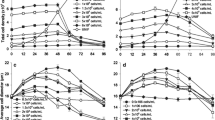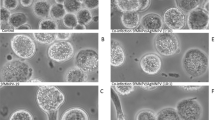Abstract
The performance of bioprocesses involving baculoviruses largely depends on an efficient infection of cells by concentrated budded virus (BV) inoculums. Baculovirus expression vector systems have been established using Autographa californica nucleopolyhedrovirus (AcMNPV), a group I NPV that displays rapid virus kinetics, whereas bioprocesses using group II baculovirus-based biopesticides such as Helicoverpa armigera nucleopolyhedrovirus (HearNPV) have the limitation of low levels of BV, as these viruses often display poor BV production kinetics. In this study, the effect of key parameters involved in the quality of progeny virions, including cell line, virus phylogenetics and medium, on viral DNA replication, virus trafficking to the extracellular environment, and the yield of recombinant protein or polyhedra were investigated in synchronous infections of HearNPV and AcMNPV. HearNPV showed higher vDNA replication in its optimum medium, SF900III, when compared to AcMNPV, but both viruses had similar specific extracellular virion content. However, the ratio of AcMNPV extracellular virions to the total number of progeny virions produced was higher, and their quality was tenfold higher than that of HearNPV extracellular virions. The results of infection of two different cell lines, High Five and Sf9, with AcMNPV, along with HearNPV infection of HzAM1 cells in three different media, suggest that the host cells and the nutritional state of the medium as well as the phylogenetics of the virus affect the BV yields produced by different baculovirus/cell line/medium combinations.




Similar content being viewed by others
References
Chakraborty S, Monsour C, Teakle R, Reid S (1999) Yield, biological activity, and field performance of a wild-type Helicoverpa nucleopolyhedrovirus produced in H-zea cell cultures. J Invertebr Pathol 73:199–205
Chen XW, Ijkel WFJ, Tarchini R, Sun XL, Sandbrink H, Wang HL, Peters S, Zuidema D, Lankhorst RK, Vlak JM, Hu ZH (2001) The sequence of the Helicoverpa armigera single nucleocapsid nucleopolyhedrovirus genome. J Gen Virol 82:241–257
Davis TR, Wickham TJ, McKenna KA, Granados RR, Shuler ML, Wood HA (1993) Comparative recombinant protein production of 8 insect cell lines. In Vitro Cell Dev Biol Animal 29A:388–390
Dee KU, Shuler ML (1997) Mathematical model of the trafficking of acid-dependent enveloped viruses: Application to the binding, uptake, and nuclear accumulation of baculovirus. Biotechnol Bioeng 54:468–490
Dee KU, Shuler ML (1997) Optimization of an assay for baculovirus titer and design of regimens for the synchronous infection of insect cells. Biotechnol Prog 13:14–24
George S, Sokolenko S, Aucoin MG (2012) Rapid and cost-effective baculovirus sample preparation method as a viable alternative to conventional preparation for quantitative real-time PCR. J Virol Methods 182:27–36
Goodman CL, McIntosh AH, El Sayed GN, Grasela JJ, Stiles B (2001) Production of selected baculoviruses in newly established lepidopteran cell lines. In Vitro Cell Dev Biol Animal 37:374–379
Haines FJ, Griffiths CM, Possee RD, Hawes CR, King LA (2009) Involvement of lipid rafts and cellular actin in AcMNPV GP64 distribution and virus budding. Virologica Sinica 24:333–349
King LA, Mann SG, Lawrie AM, Mulshaw SH (1991) Replication of wild -type and recombinant Autographa californica nucleopolyhedrosis virus in cell line derived from Mamestra brassicae. Virus Res 19:93–104
Kost TA (2012) Baculovirus technology: protein expression, drug discovery, vaccines, what next? In Vitro Cell Dev Biol Animal 48:10
Krammer F, Schinko T, Palmberger D, Tauer C, Messner P, Grabherr R (2010) Trichoplusia ni cells (High Five(TM)) are highly efficient for the production of influenza A virus-like particles: a comparison of two insect cell lines as production platforms for influenza vaccines. Mol Biotechnol 45:226–234
Li JJ, Sun B, Han H, Ouyang JF, Yao HC, Yang YB, Liu KY, Li Y (2012) Application of baculovirus as a delivery vehicle for study of transcription and translation mechanism of parvovirus in non-permissive mammalian cells. J Virol Methods 183:1–7
LifeTechnologies (2012) Sf-900™ III SFM In: Invitrogen (ed). http://www.invitrogen.com/site/us/en/home/Products-and-Services/Applications/Cell-Culture/Insect-Cell-Culture/Insect_Cell_Culture-Misc/Sf-900-III-SFM-the-reliable-choice-for-insect-cells.html, Life Technologies
Long G, Pan XY, Westenberg M, Vlak JM (2006) Functional role of the cytoplasmic tail domain of the major envelope fusion protein of group II baculoviruses. J Virol 80:11226–11234
Long G, Westenberg M, Wang HL, Vlak JM, Hut ZH (2006) Function, oligomerization and N-linked glycosylation of the Helicoverpa armigera single nucleopolyhedrovirus envelope fusion protein. J Gen Virol 87:839–846
Lung O, Westenberg M, Vlak JM, Zuidema D, Blissard GW (2002) Pseudotyping Autographa californica multicapsid nucleopolyhedrovirus (AcMNPV): F proteins from group IINPVs are functionally analogous to AcMNPV GP64. J Virol 76:5729–5736
Lynn DE (2001) Effects of temperature on the susceptibility of insect cells to infection by baculoviruses. Methods Cell Sci 23:221–225
Mao HT, Song JH, Liang CY, Yu ZH, Chen XW (2006) Construction of eukaryotic surface display based on the baculoviral F protein. Biotechniques 41:266–268
Matindoost L, Chan LCL, Qi YM, Nielsen LK, Reid S (2012) Suspension culture titration: A simple method for measuring baculovirus titers. J Virol Methods 183:201–209
McIntosh AH, Christian PD, Grasela JJ (1999) The establishment of heliothine cell lines and their susceptibility to two baculoviruses. In Vitro Cell Dev Biol Animal 35:94–97
Milks ML, Washburn JO, Willis LG, Volkman LE, Theilmann DA (2003) Deletion of pe38 attenuates AcMNPV genome replication, budded virus production, and virulence in Heliothis virescens. Virology 310:224–234
Nielsen LK, Smyth GK, Greenfield PF (1991) Hemacytometer cell count distributions - Implications of non-poisson behavior. Biotechnol Prog 7:560–563
Ogembo JG, Chaeychomsri S, Caoili BL, Ikeda M, Kobayashi M (2008) Susceptibility of the Cell Line Hv-AM1 from Heliothis virescens to Eight Selected Nucleopolyhedroviruses. J Insect Biotechnol Sericol 77:141–150
Ogembo JG, Chaeychomsri S, Caoili BL, Ikeda M, Kobayashi M (2008) Susceptibility of newly established cell lines from Helicoverpa armigera to homologous and heterologous Nucleopolyhedroviruses. J Insect Biotechnol Sericol 77:25–34
Ohkawa T, Volkman LE, Welch MD (2010) Actin-based motility drives baculovirus transit to the nucleus and cell surface. J Cell Biol 190:187–195
Pasumarthy MK, Murhammer DW (1995) Variation in recombinant protein expression levels among clones of lepidopteran cell populations. Enzyme Microb Technol 17:168–174
Pearson MN, Groten C, Rohrmann GF (2000) Identification of the Lymantria dispar nucleopolyhedrovirus envelope fusion protein provides evidence for a phylogenetic division of the Baculoviridae. J Virol 74:6126–6131
Pedrini MRS, Reid S, Nielsen LK, Chan LCL (2011) Kinetic characterization of the group II Helicoverpa armigera Nucleopolyhedrovirus propagated in suspension cell cultures: Implications for development of a biopesticides production process. Biotechnol Prog 27:614–624
Petricevich VL, Palomares LA, Gonzalez M, Ramirez OT (2001) Parameters that determine virus adsorption kinetics: toward the design of better infection strategies for the insect cell-baculovirus expression system. Enzyme Microb Technol 29:52–61
Rosinski M, Reid S, Nielsen LK (2002) Kinetics of baculovirus replication and release using real-time quantitative polymerase chain reaction. Biotechnol Bioeng 77:476–480
Sander L, Harrysson A (2007) Using cell size kinetics to determine optimal harvest time for Spodoptera frugiperda and Trichoplusia ni BTI-TN-5B1-4 cells infected with a baculovirus expression vector system expressing enhanced green fluorescent protein. Cytotechnology 54:35–48
Sokolenko S, George S, Wagner A, Tuladhar A, Andrich JMS, Aucoin MG (2012) Co-expression vs. co-infection using baculovirus expression vectors in insect cell culture: Benefits and drawbacks. Biotechnol Adv 30:766–781
Volkman LE, Goldsmith PA (1982) Generalized immunoassay for Autographa californica nucleopolyhedrosis virus infectivity in vitro. Appl Environ Microbiol 44:227–233
Wang ML, Yin FF, Shen S, Tan Y, Deng F, Vlak JM, Hu ZH, Wang HL (2010) Partial functional rescue of Helicoverpa armigera Single Nucleocapsid Nucleopolyhedrovirus infectivity by replacement of F protein with GP64 from Autographa californica Multicapsid Nucleopolyhedrovirus. J Virol 84:11505–11514
Washburn JO, Trudeau D, Wong JF, Volkman LE (2003) Early pathogenesis of Autographa californica multiple nucleopolyhedrovirus and Helicoverpa zea single nucleopolyhedro virus in Heliothis virescens: a comparison of the ‘M’ and ‘S’ strategies for establishing fatal infection. J Gen Virol 84:343–351
Westenberg M, Wang HL, Ijkel WFJ, Goldbach RW, Vlak JM, Zuidema D (2002) Furin is involved in Baculovirus envelope fusion protein activation. J Virol 76:178–184
Westenberg M, Veenman F, Roode EC, Goldbach RW, Vlak JM, Zuidema D (2004) Functional analysis of the putative fusion domain of the baculovirus envelope fusion protein F. J Virol 78:6946–6954
Wickham TJ, Granados RR, Wood HA, Hammer DA, Shuler ML (1990) General analysis of receptor-mediated viral attachment to cell surfaces. Biophys J 58:1501–1516
Wickham TJ, Davis T, Granados RR, Shuler ML, Wood HA (1992) Screening of insect cell lines for the production of recombinant proteins and infctious virus in the Baculovirus expression system. Biotechnol Prog 8:391–396
Wickham TJ, Nemerow GR (1993) Optimization of growth methods and recombinant protein production in BTI-TN-5B1-4 insect cells using the Baculovirus Expression System. Biotechnol Prog 9:25–30
Wu WB, Passarelli AL (2012) The Autographa californica M Nucleopolyhedrovirus ac79 Gene encodes an early gene product with structural similarities to UvrC and intron-encoded endonucleases that is required for efficient Budded Virus production. J Virol 86:5614–5625
Yamagishi J, Burnett ED, Harwood SH, Blissard GW (2007) The AcMNPV pp 31 gene is not essential for productive AcMNPV replication or late gene transcription but appears to increase levels of most viral transcripts. Virology 365:34–47
Zhang YH, Enden G, Merchuk JC (2005) Insect cells-baculovirus system: Factors affecting growth and low MOI infection. Biochem Eng J 27:8–16
Author information
Authors and Affiliations
Corresponding author
Electronic supplementary material
Below is the link to the electronic supplementary material.
Rights and permissions
About this article
Cite this article
Matindoost, L., Hu, H., Chan, L.C.L. et al. The effect of cell line, phylogenetics and medium on baculovirus budded virus yield and quality. Arch Virol 159, 91–102 (2014). https://doi.org/10.1007/s00705-013-1789-1
Received:
Accepted:
Published:
Issue Date:
DOI: https://doi.org/10.1007/s00705-013-1789-1




